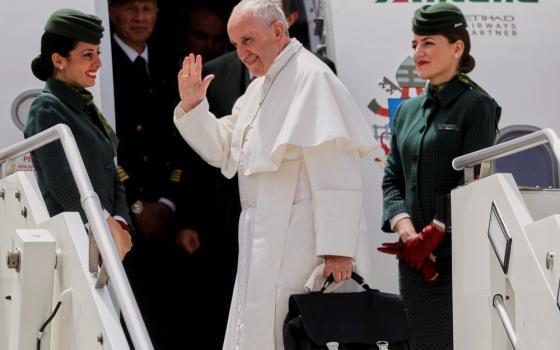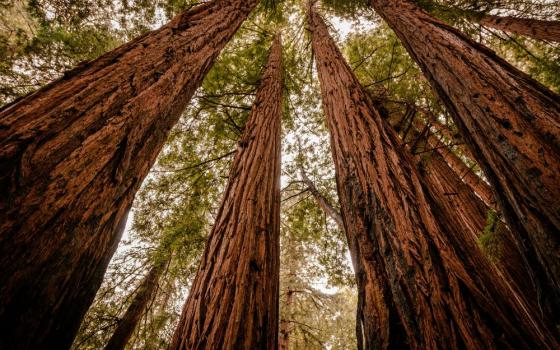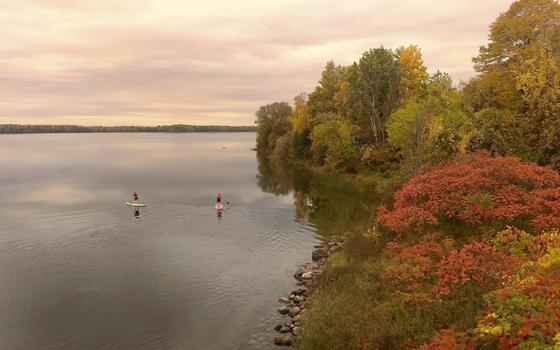
(Unsplash/Katerina May)
On my best mornings, I stumble out of bed and land on my meditation cushion where I spend at least 20 minutes in contemplative prayer. I acknowledge that I am in the presence of God, and then dedicate the time to abide in God's love, recalling the Gospel writer John's words, "Abide in me as I abide in you" (John 15:4).
My breath serves as an anchor as I draw my attention to the sensations of each inhalation and exhalation, allowing me to enter into the present moment. The prayer is silent and wordless. My heart is directed to God. It is, as the Catechism of the Catholic Church describes contemplative prayer, "silent love."
Contemplative prayer has been a foundation for my relationship with God for the last 25 years, ever since I was introduced to meditation. Praying with breath and body as a whole is an essential way to bring my full self into the present moment. Instead of getting caught in the head with my thoughts and ideas, this contemplative practice creates space for God's healing power and transformative love to do its work.
As Jesus said about the one who scatters seed on the ground which then sprouts and grows, "he does not know how" (Mark 4:27), so is the process of meditation. I submit myself in the silence, and trust that to be open to receive God's Word and love is enough. Some of my deepest insights and most intimate senses of connection have arisen in silence. And when I don't engage in contemplative prayer, I am more reactive and less centered. Something is happening, even if I do not know how or why.
Often we think contemplation with creation solely means praying with nature. While praying with nature is part of this practice, we cannot forget that we, too, are creation. Once after a Laudato Si' Retreat I gave in New York City, a participant (a kind theology professor) reminded me that creation is not just something outside us. It is also within. To pray with creation also means to pray with our bodies — temples of the Holy Spirit (1 Corinthians 6:19), created in the image of God as both corporeal and spiritual.
Being present to the sensations of breathing with one's mind and heart raised to God is prayer.
One fundamental way of praying with the body is with the breath. This isn't a new idea. There is a tradition of praying with the breath in Christianity. In Genesis, God forms Adam from the dust of the Earth and breathes "the breath of life" into him. The word "spirit" comes from the Hebrew translation of ruah which means "breath, air and wind." This word used as a divine attribute for a member of the Trinity is the same word used to signify God breathing life into Adam and the Holy Spirit's breath upon the first apostles at Pentecost. The breath has always been seen as sacred. We see the beginnings of a more formal version of breath meditation in the Desert Fathers and the Hesychast tradition.
For those of us striving for ecological conversion, meditation rooted in the breath reminds us of our interconnection with Earth's elements, in particular the element of air. As Pope Francis states at the beginning of Laudato Si', "we ourselves are dust of the earth (cf. Gen 2:7); our very bodies are made up of her elements, we breathe her air and we receive life and refreshment from her waters."
In my last essay for this series, I reflected on pausing as the first step in contemplation. The next step is connecting with physical sensations present in the body. One of the gifts of the body is that awareness of our physical sensations — our actual perceptions through the senses — brings us into the present moment.
To contemplate with the breath, we bring awareness to our physical experience of inhalation and exhalation, wherever it is strongest. This might be at the nostrils, or in the rise and fall of the belly or chest. We might bring awareness of breathing in and out of the heart as a way to deepen connection to the heart space.
St. John Damascene said, "Prayer is the raising of one's mind and heart to God." And being present to the sensations of breathing with one's mind and heart raised to God is prayer.
If the mind is distracted, it can be helpful to connect a word or phrase to praying with the physical sensations of the breath. This could be the word "Jesus," similar to the Way of a Pilgrim, or the words "laudato si'," which means "praised be," from the first line of St. Francis of Assisi's canticle. When I pray "lauda" with an inhalation and "-to si'," with the outbreath, it reminds me that with each breath I can offer praise to God.
Praying with the breath can remind us of our complete and utter dependence on God. Just as God breathed life into Adam, God breathes life into us with each inhalation. A root of our ecological destruction is humanity's distorted understanding of ourselves as the center, with a false reliance on our own power. As stated in Laudato Si', "We are not God. The earth was here before us and it has been given to us." Remembering that each breath is a gift from God can instill a sense of gratitude for the gift of life we receive each moment, while also reminding us that this breath can just as easily be taken from us due to the unpredictability of life.
Praying with the breath can also help remind us of how interconnected we are with all beings. The oxygen we breathe comes from the plants, trees and algae whose biological processes recycle carbon dioxide in the air for their own food. Around 70% of the oxygen in our atmosphere comes from algae in the ocean!
This air we are breathing is also the same air breathed by all living beings on our planet, a reality that became starkly evident with the quick spread of COVID-19. We can extend this reflection by also realizing that we are breathing the same air as all living beings past and future. So as we breathe, we can imagine the whole Trinity within the experience: God breathing the "breath of life," the Holy Spirit in each breath or ruah, and the possibility that Jesus inhaled this very same air.
Advertisement
If contemplating with the breath is challenging for you, there are other ways to contemplate with the body as part of creation. You could focus on a part of your body, like your hands, or focus awareness on one of your senses, such as hearing. (The next essay in this series will further explore praying with the senses as a way to pray with creation and with our bodies.)
One of the blessings of praying with the body is that the body is always with us. We breathe every second of the day. And this gift of our corporeal being was shared by Jesus. Praying with this "temple of the Holy Spirit" is a way to deepen our relationship with creation and our Creator through the gift of our incarnated selves.
As we explore praying with the body and breath we might reflect on these words from Pope Francis:
For Christians, all the creatures of the material universe find their true meaning in the incarnate Word, for the Son of God has incorporated in his person part of the material world, planting in it a seed of definitive transformation. "Christianity does not reject matter. Rather, bodiliness is considered in all its value in the liturgical act, whereby the human body is disclosed in its inner nature as a temple of the Holy Spirit and is united with the Lord Jesus, who himself took a body for the world's salvation."








